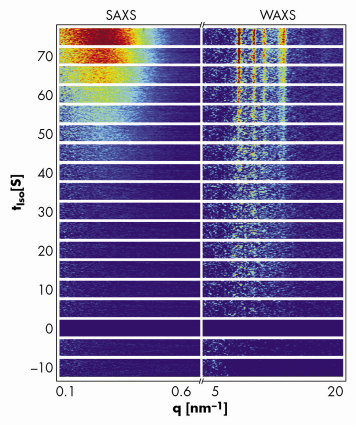- Home
- Users & Science
- Scientific Documentation
- ESRF Highlights
- ESRF Highlights 2007
- Soft Condensed Matter
- Early stages of polymer melt crystallisation
Early stages of polymer melt crystallisation
Unlike low molecular weight chemical compounds, polymeric materials do not transform to perfect crystals and usually turn into a metastable state that is partly crystalline and partly amorphous. This semi-crystalline structure, which develops during the solidification process, primarily controls the mechanical and physical properties of solid polymers. Polymer crystallisation has consequently been a topic of both fundamental and practical interest over the past half century [1]. It has been well established that the transformation of an entangled melt into a semi-crystalline state is a multi-step process. Despite enormous progress in understanding the mechanism of melt crystallisation, the initial step in the ordering process remains a subject of debate [2]. In recent years, there are somewhat contradictory reports on the early stage of crystallisation, deviating from the classical nucleation and growth mechanism. X-ray scattering techniques have been widely used in the investigation of different facets of polymer crystallisation but they suffer from the detection limits at such low crystalline fraction. This threshold of detection could introduce an apparent delay in the appearance of crystalline diffraction.
In order to unravel these scenarios of polymer crystallisation, we have reinvestigated the early stage of isotactic polypropylene (i-PP) crystallisation with unprecedented sensitivity and time resolution at the beamline ID02 using combined small-angle and wide-angle X-ray scattering (SAXS/WAXS, respectively). We have followed identical crystallisation protocols as in the previous studies and in addition we precisely determined the isothermal condition (tIso=0) from the scattered intensity itself. Figure 57 shows the onset of the evolution of normalised SAXS and WAXS intensities as a function of isothermal time (tIso). The most striking feature of this plot is the clear evolution of WAXS signal prior to SAXS in contrast to previous experimental reports. The initial WAXS intensity appeared as a relatively broad peak and the SAXS signal started to evolve significantly after the emergence of nearly sharp diffraction peaks in WAXS.
 |
|
Fig. 57: Azimuthal sectors of SAXS and WAXS patterns recorded simultaneously following a rapid temperature quench to the crystallisation temperature of 145°C (tIso evolves after the sample reached the isothermal condition). The diffraction from crystalline (WAXS) nuclei is evident prior to significant evolution of SAXS. From each frame the melt background (tIso=0) has been subtracted. |
Figure 58 presents the evolution of the scattering invariant (QI) and crystallinity (XC) calculated from the normalised SAXS and WAXS intensities, respectively. Qualitatively, both quantities follow an exponential type growth, identical to the Avrami function conventionally used to describe crystallisation kinetics. However, an important feature in Figure 58 is that the initial growths of XC and QI significantly deviate from the Avrami behaviour as shown in the inset. The unprecedented sensitivity allowed us to detect the initial level of XC, which appeared as broad peaks in the WAXS pattern prior to the onset of significant evolution of SAXS intensity. This plateau in crystallinity could be originating from the so-called baby nuclei observed in computer simulations [2]. In this metastable state, only the most favourable nuclei survive while nascent nuclei appear spontaneously resulting in a constant level of crystallinity (tIso< 30 s). The semi-crystalline lamellar morphology is destined at the following stage. As depicted in the inset of Figure 58, XC and QI follow power-law type growths, tIso3/2 and tIso3, respectively. For constant thickness of lamellae, XC ![]() tIso3/2 corresponds to a lateral growth of lamellae by tIso3/4 analogous to that seen in computer simulations [1]. The growth kinetics at subsequent stage is adequately described by the Avrami function with an exponent, n ~ 1 that implies high crystal nucleation rate and short induction period. The limit of detection usually reported in the literature is indicated by the green dotted line in Figure 58. This could explain why the SAXS intensity evolved prior to the onset of WAXS signal in previous experiments [2].
tIso3/2 corresponds to a lateral growth of lamellae by tIso3/4 analogous to that seen in computer simulations [1]. The growth kinetics at subsequent stage is adequately described by the Avrami function with an exponent, n ~ 1 that implies high crystal nucleation rate and short induction period. The limit of detection usually reported in the literature is indicated by the green dotted line in Figure 58. This could explain why the SAXS intensity evolved prior to the onset of WAXS signal in previous experiments [2].
 |
|
Fig. 58: Evolution of crystallinity and SAXS invariant during the early stages. The continuous lines show Avrami type growth kinetics with n ~ 1 and |
In conclusion, the unprecedented sensitivity realised in SAXS/WAXS experiments allowed us to detect the primary nucleation events in polymer crystallisation from melt. The crystalline lamellar long period is affixed at this early stage and the crystallisation kinetics follow the classical nucleation and growth behaviour. Furthermore, the growth exponent n depends on a whole host of parameters, in addition to the dimensionality of crystal growth as demonstrated by models involving cluster distribution rate equation.
References
[1] A. Keller and S.Z.D. Cheng, Polymer 39, 4461 (1998).
[2] M. Muthukumar, Adv. Polym. Sci. 191, 241 (2005) and references therein.
Principal publication and authors
P. Panine, E. Di Cola, M. Sztucki, and T. Narayanan, Polymer (2008), doi: 10.1016/j.polymer.2007.12.026.
ESRF



